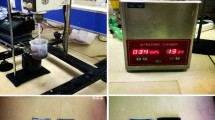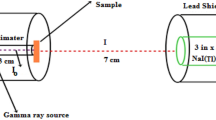Abstract
Properties such as gamma shielding, cure characteristics, and mechanical properties of natural rubber (NR) system with addition of oxides such as: iron (II, III) oxide (Fe3O4), tungsten (III) oxide (W2O3), or bismuth (III) oxide (Bi2O3) were studied for potential replacement of flexible lead (Pb), and introduced as gamma-shielding materials, to minimize risks caused by Pb. The results showed that increase in the content of oxides such as Fe3O4, W2O3, or Bi2O3 from 0 to 100, 300, and 500 parts/100 parts of rubber by weight (phr) increased the gamma attenuation coefficients, tensile modulus at 100% elongation, and hardness (Shore A), though they reduced the tensile strength and elongation-at-break. The composites also underwent thermal aging tests at 70 °C for 96 h. The results indicated slight reduction in the overall tensile properties. Specifically, for NR composites with 300 or 500 phr of Bi2O3, the mass attenuation coefficients (μ m) of these composites were the highest among other composites and even higher than lead sheets that were measured using the same set-up. The outcome of the results imply great possibilities of replacing hazardous lead-containing gamma-shielding materials with the investigated composites, while still providing safe and efficient gamma-shielding properties for the users.







Similar content being viewed by others
References
Kihlstrom L, Karlsson B, Lindquist C (1993) Gamma knife surgery for cerebral metastases. Implications for survival. Sterotact Funct Neurosurg 61:45–50
Rogers CL, Shetter AG, Jeffrey AF, Smith KA, Han PP, Speiser BL (2000) Gamma knife radiosurgery for trigeminal neuralgia: the initial experience of The Barrow Neurological Institute. Int J Radiat Oncol Biol Phys 47:1013–1019
O’Keeffe S, Fernandez AF, Fitzpatrick C, Brichard B, Lewis E (2007) Real-time gamma dosimetry using PMMA optical fibres for applications in the sterilization industry. Meas Sci Technol 18:3171–3176
Puchooa D (2005) In vitro mutation breeding of anthurium by gamma radiation. Int J Agric Biol 7:11–20
Sangsiri C, Sorajjapinun W, Srinives P (2005) Gamma radiation induced mutations in mungbean. Sci Asia 31:251–255
Bertozzi W, Ledoux R (2005) Nuclear resonance fluorescence imaging in non-intrusive cargo inspection. Nucl Instrum Methods Phys Res B 241:820–825
Taskin H, Karavus M, Ay P, Topuzoglu A, Hidiroglu S, Karahan GJ (2009) Radionuclide concentrations in soil and lifetime cancer risk due to gamma radioactivity in Kirklareli, Turkey. Environ Radioact 100:49–53
Menzies D, Joshi R, Pai M (2007) Risk of tuberculosis infection and disease associated with work in health care settings [State of the Art Series, Occupational lung diseases in high- and low-income countries]. Int J Tuberc Lung Dis 11:595–605
Strauss KJ, Kaste SC (2006) The ALARA (as low as reasonably achievable) concept in pediatric interventional and fluoroscopic imaging: striving to keep radiation doses as low as possible during fluoroscopy of pediatric patients—a white paper executive summary. Radiology 240:621–622
Arons AB, Peppard MB (1965) Einstein’s proposal of the photon concept-a translation of the annalen der physic paper of 1905. Am J Phys 33:367–374
Christillin P (1986) Nuclear Compton scattering. J Phys G Nucl Phys 12:837–851
Hubbell JH (2006) Electron–positron pair production by photons: a historical overview. Radiat Phys Chem 75:614–623
Singh KJ, Singh N, Kaundal RS, Singh K (2008) Gamma-ray shielding and structural properties of PbO–SiO2 glass. Nucl Instr Methods Phys Res B 266:944–948
Kaundal RS, Kaur S, Singh N, Singh KJJ (2010) Investigation of structural properties of lead strontium borate glasses for gamma-ray shielding applications. Phys Chem Solids 71:1191–1195
El-Kameesy SU, El-Zaiat SY, Youssef GM, Abd El-Kawy FS (2016) Gamma ray and neutron shielding properties of lead borate glass containing sodium, aluminium and zinc oxides. Glob J Phys 4:395–399
Harish V, Nagaiah N, Prabhu TN, Varughese KTJ (2009) Preparation and characterization of lead monoxide filled unsaturated polyester based polymer composites for gamma radiation shielding applications. J Appl Polym Sci 112:1503–1508
Gwaily SE, Madani M (2002) Lead–natural rubber composites as gamma radiation shields. II: high concentration. Polym Compos 23:495–499
Seregin IV, Ivanov VB (2001) Physiological aspects of cadmium and lead toxic effects on higher plants. Russ J Plant Physiol 48:523–544
Demayo A, Taylor MC, Taylor KW, Hodson PV, Hammond PB (1982) Toxic effects of lead and lead compounds on human health, aquatic life, wildlife plants, and livestock. Crit Rev Environ Control 12:257–305
Needleman HL, Landrigan PJ (2004) What level of lead in blood is toxic for a child? Am J Public Health 94:8
Singh VP, Badiger NM, Chantima N, Kaewkhao J (2014) Evaluation of gamma-ray exposure buildup factors and neutron shielding for bismuth borosilicate glasses. Radiat Phys Chem 98:14–21
Singh AK, Singh RK, Sharma B, Tyagi AK (2017) Characterization and biocompatibility studies of lead free X-ray shielding polymer composite for healthcare application. Radiat Phys Chem 138:9–15
Nambiar S, Osei E, Yeow JTW (2012) Polymer nanocomposite-based shielding against diagnostic X-rays. J Appl Polym Sci 131:4939–4946
El-Khayatt AM, Ali AM, Singh VP (2014) Photon attenuation coefficients of heavy-metal oxide glasses by MCNP code, XCOM program and experimental data: a comparison study. Nucl Instrum Methods Phys Res A 735:207–212
Tekin HO, Singh VP, Manici T (2017) Effects of micro-sized and nano-sized WO3 on mass attenuation coefficients of concrete by using MCNPX code. Appl Radiat Isot 121:122–125
Ramesan MT (2015) Effects of magnetite nanoparticles on morphology, processability, diffusion and transport behavior of ethylene vinyl acetate nanocomposites. Int J Plast Technol 19:368–380
Ramesan MT (2015) Poly(ethylene-co-vinyl acetate)/magnetite nanocomposites: interaction of some liquid fuels, thermal and oil resistance studies. Polym Polym Compos 23:85–92
Ninyong K, Wimolmala E, Sombatsompop N, Saenboonruang K (2017) Potential use of NR and wood/NR composites as thermal neutron shielding materials. Polym Test 59:336–343
Jaiyen S, Phumsuwan A, Thongpool V, Phunpueok A (2017) Determination of radiation attenuation coefficient of rubber containing barite. Appl Mech Mater 866:204–207
El-Sabbagh SH, Yehia AA (2007) Detection of crosslink density by different methods for natural rubber blended with SBR and NBR. Egypt J Solids 30:157–173
Zhao F, Bi W, Zhao S (2011) Influence of crosslink density on mechanical properties of natural rubber vulcanizates. J Macromol Sci B 50:1460–1469
Wang Z, Zhang X, Wang F, Lan X, Zhou Y (2016) Effects of aging on the structural, mechanical, and thermal properties of the silicone rubber current transformer insulation bushing for a 500 kV substation. SpringerPlus 5:790
Nelson G, Reilly D (2017) Gamma-ray interactions with matter. http://www.lanl.gov/orgs/n/n1/panda/00326397.pdf. Accessed 1 June 2017
Sharaf JM, Salah H (2015) Gamma-ray energy buildup factor calculations and shielding effects of some Jordanian building structures. Radiat Phys Chem 110:87–95
Acknowledgements
This work was supported by a Graduate Program Scholarship from the Graduate School, Kasetsart University, Bangkok, Thailand. We would also like to acknowledge the support from the Faculty of Science, Kasetsart University and the Rubber Technological Test Center, Central Region, Bangkok, Thailand.
Author information
Authors and Affiliations
Corresponding author
Rights and permissions
About this article
Cite this article
Toyen, D., Rittirong, A., Poltabtim, W. et al. Flexible, lead-free, gamma-shielding materials based on natural rubber/metal oxide composites. Iran Polym J 27, 33–41 (2018). https://doi.org/10.1007/s13726-017-0584-3
Received:
Accepted:
Published:
Issue Date:
DOI: https://doi.org/10.1007/s13726-017-0584-3




